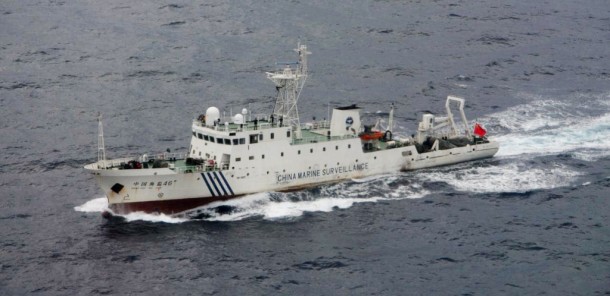BEIJING—A territorial flare-up between China and Japan intensified as two Beijing-sent patrol ships arrived near disputed East China Sea islands in a show of anger over Tokyo’s purchase of the largely barren outcroppings from their private owners.
The China Marine Surveillance has drawn up a plan to safeguard China’s sovereignty of the islands and the ships were sent to assert those claims, China’s official Xinhua News Agency said on Tuesday. The marine agency is a paramilitary force whose ships are often lightly armed.
The rocky islands, known as Senkaku to Japanese and Diaoyu to Chinese, have been the focus of recurring spats between the countries and also are claimed by Taiwan. The China-Japan dispute has been heating up in recent months, in part because the nationalist governor of Tokyo proposed buying the islands and developing them.
Japan’s central government announced its own deal this week with the Japanese family it recognizes as the owner. Chief Cabinet Secretary Osamu Fujimura told reporters the government budgeted 2.05 billion yen (US $26 million) for the purchase “to maintain the Senkakus peacefully and stably.”
Public broadcaster NHK said the government and the family signed a deal on Tuesday.
Beijing responded to the move with fury.
“The determination and the will of the Chinese government and military to safeguard their territorial integrity are firm,” Chinese Defense Ministry spokesman Geng Yansheng said in a statement. “We are closely monitoring the development of the situation and reserve the right to take necessary measures.”
Japan has claimed the islands since 1895. The US took jurisdiction after World War II and turned them over to Japan in 1972. But Beijing sees the purchase as an affront to its claims and its past calls for negotiations.
Japan does not plan to develop the islands, in contrast with the proposal made by Tokyo Gov. Shintaro Ishihara.
“Ishihara put the national government in a very difficult spot. He pushed them into doing this now,” said Sheila Smith, a senior fellow at the Council on Foreign Relations in Washington. But she said this was a “good outcome” that should be seen as an attempt by Tokyo to sideline Ishihara.
Japan cannot afford to let the dispute hinder its vital ties with China, its top trading partner, Smith said.
The United States urged Japan and China to solve the dispute through dialogue. Japan is a staunch US ally, but Washington says it does not take a position on the conflicting territorial claims. It also does not want to further strain its own relations with China.
“In the current environment we want cooler heads to prevail,” Kurt Campbell, the top US diplomat for East Asia, said in Washington. “This [the Asia-Pacific] is the cockpit of the global economy and the stakes could not be bigger. The desire is for all leaders to keep that in mind.”
Carlyle Thayer, an expert on regional security at the University of New South Wales in Australia, said the sending of the Chinese patrol boats “ups the stakes.”
“It’s a tit-for-tat response because China is extremely sensitive about sovereignty matters,” he said.
Japan’s coast guard said it has not taken any special measures in response to the Chinese patrol boats although it continues to monitor the situation.
Thayer said the Chinese boats would likely stop short of entering the 12 nautical miles around the islands that are considered territorial waters and administered by Japan.
“Japan has a pretty robust navy, a very strong and active professional coast guard. What is possible are the kinds of confrontations like occurred at Scarborough Shoal,” a disputed reef where Chinese and Philippine boats faced off earlier this year.
“It’s all posturing. It’s a game of who blinks first,” Thayer said.
Beijing’s anger has been accompanied by heated reporting in China’s state media. Reactions to Japanese actions are sometimes overstated in China, and a commentator in the People’s Liberation Army Daily, the main newspaper of China’s military, called Japan’s move “the most blatant challenge to China’s sovereignty since the end of World War II.”
About a dozen protesters gathered outside the Japanese Embassy in Beijing chanting, “Japan, get out of China.” Xinhua reported that people had also taken to the streets to protest in two cities in the south and east.
Taiwan’s Foreign Ministry also lodged a strong protest to Japan. It called the island purchase an “extremely unfriendly move” that “not only harms the longtime cooperation between Taiwan and Japan but will also aggravate regional tensions in East Asia.”
Top Japanese government officials maintain that the flare-up hasn’t affected official ties with China. Deputy Prime Minister Katsuya Okada said activists on both sides were fanning emotions.
Prime Minister Yoshihiko Noda met only briefly with Chinese President Hu Jintao on the sidelines of this past weekend’s Asia Pacific Economic Cooperation summit in Vladivostok, Russia. Japanese news reports said Noda emphasized the importance of dealing with the island dispute from a broad perspective.
China also has announced coordinates marking out the waters off the Diaoyu Islands that it considers its territory, apparently for the first time after doing so earlier for the mainland and other islands.
The coordinates are another step, along with recent announcements of China’s intention to use law enforcement vessels, to defend its sovereignty claim, said Stephanie Kleine-Ahlbrandt, northeast Asia project director for the International Crisis Group.
In Tokyo, Gov. Ishihara said he would release 1.4 billion yen ($18 million) donated toward his islands purchase plan to the central government, but only once it was clear whether it would heed his calls to build a port or other facilities.
He also suggested that Japan cooperate with the Philippines and Vietnam, which have their own territorial disputes with China in the South China Sea.
“We shouldn’t see this as an issue that only concerns Japan,” he said.















